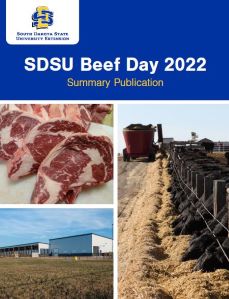
SDSU Beef Day 2022 Summary Publication
Document Type
Article
Publication Date
1-20-2022
Abstract
Study Description:
Ejaculated and epididymal semen was collected from mature Angus bulls (n = 9), and then centrifuged to separate sperm and fluid. Fluids were collected and sperm pellets were resuspended in a high ionic solution and vortexed to remove loosely attached proteins. Sperm samples were centrifuged, and the supernatant was collected. Samples collected for protein analysis were snap frozen in liquid nitrogen and stored at -80 ºC. Protein analysis was performed by liquid chromatography with tandem mass spectrometry (LCMS/MS). Yearling Angus cross bulls (n = 40) were used for sperm cultures. Ejaculated (n = 20) and epididymal (n = 20) sperm were collected, diluted and cultured in a commercial media at pH 5.8, 6.8 and 7.3, at 4 ºC and evaluated for motility and viability every 24 h until motility was below 20%. There was an effect of pH, time and pH by time interaction for motility and viability for both ejaculated and epididymal sperm (P ≤ 0.05). At 216 h of incubation epididymal sperm at pH 7.3 and ejaculated sperm at pH 6.8 dropped below 20% motility. Overall, in all samples, a total of 458 unique proteins were identified. It was identified that ejaculated fluid and ejaculated sperm had 178 and 298 proteins, respectively. Also, it was identified that epididymal fluid and epididymal sperm had 311 and 344 proteins, respectively. There were Kyoto Encyclopedia of Genes and Genomes (KEGG) pathways significantly enriched (FDR < 0.05) for ejaculated fluid (n = 8), epididymal fluid (n = 24), ejaculated sperm (n = 10), and epididymal sperm (n = 18). The most important KEGG pathway identified was the metabolic pathway. Within the metabolic pathway the glycolysis/gluconeogenesis, pentose phosphate, and glutathione metabolism pathways were significantly enriched among proteins only present in epididymal samples. Other proteins identified that may be related to epididymal sperm’s increased longevity were peroxidases and glutathione peroxidases for their antioxidant properties.
Pages
14
Publisher
South Dakota State University
Rights
© 2022 South Dakota Board of Regents
Recommended Citation
Zoca, Saulo Menegatti; Northrop-Albrecht, Emmalee J.; Walker, Julie; Cushman, Robert A.; and Perry, George, "Proteomic Analysis of Epididymal and Ejaculated Sperm and Respective Fluids" (2022). SDSU Beef Day 2022 Summary Publication. 10.
https://openprairie.sdstate.edu/sd_beefday_2022/10
